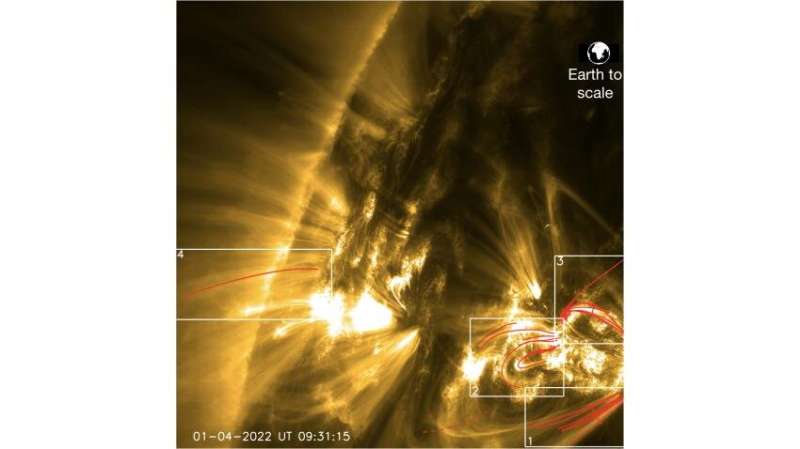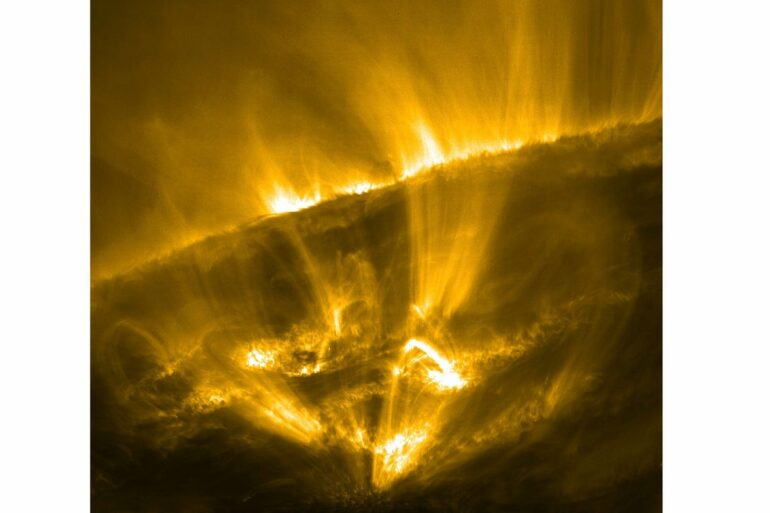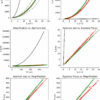A team of astronomers from several European institutions led by Northumbria University in Newcastle has discovered “shooting stars” on the sun. Observations from the European Space Agency’s Solar Orbiter (SolO) have revealed never-before-seen “falling star”-type phenomena or meteor-like fireballs occurring within the spectacular plasma displays known as coronal rain. The work will be presented this week at the National Astronomy Meeting (NAM 2023) by lead author Patrick Antolin, Assistant Professor at Northumbria University.
Although not real water, coronal rain is a condensation process in which some of the sun’s fiery material clumps together due to sudden, localized temperature drops. The corona, which is the outermost part of the sun’s atmosphere, is formed of gas at million-degree temperatures, and quick drops in temperature produce super-dense clumps of plasma that reach 250 kilometers wide. These fiery balls plummet back down towards the sun as gravity pulls them in at more than 100 kilometers per second.
The research will be published in a special issue of Astronomy & Astrophysics dedicated to SolO’s first close perihelion to the sun. It is currently available on the pre-print server arXiv. In spring 2022, SolO cruised super close to the sun at a distance of only 49 million kilometers—a third of the distance between the Earth and the sun—allowing the best spatial resolution ever obtained of the solar corona.
Along with the first super-high-resolution images of the coronal rain clumps, SolO observed the heating and compression of gas immediately underneath them. The resulting spike in intensity below the clumps indicates that the gas is heated up to a million degrees, which lasts for a few minutes as they fall.

SolO view in the EUV on 1 April 2022 showing a partial section of the Sun with gas at 1 million degrees. The red paths correspond to some of the rain tracks analyzed in this work. The Earth image has been overlaid to scale © Patrick Antolin. Background image: ESA/Solar Orbiter EUI/HRI
On Earth, “shooting stars” happen when meteoroids, or objects in space that range in size from dust grains to small asteroids, enter our atmosphere at high speeds and burn up. Only some meteors make it to the ground without disintegrating and those that do can produce huge craters.
But the sun’s corona is thin and low in density and does not strip much material off the clumps, so scientists think most of the “shooting stars” make it to the solar surface intact. Their impacts have never been observed until now and SolO’s observations have revealed that this process can produce a brief, strong brightening with an upward surge of material and shock waves that reheat the gas above.
“Shooting stars” and meteors in Earth’s atmosphere are characterized by a trace behind the meteor’s path, formed when heated material underneath strips off parts of the object—a process called ablation. The same happens to comets orbiting the sun. However, ablation does not occur in the solar corona because of its magnetic field. Instead, falling gas is partially ionized and follows the magnetic field lines, which act as giant tubes that funnel the gas. The compression and heat underneath prevents the clumps from producing tails and makes the phenomenon much harder to capture on the sun.
The project’s lead author, Patrick Antolin, says, “The inner solar corona is so hot we may never be able to probe it in situ with a spacecraft. However, SolO orbits close enough to the sun that it can detect small-scale phenomena occurring within the corona, such as the effect of the rain on the corona, allowing us a precious indirect probe of the coronal environment that is crucial to understanding its composition and thermodynamics. Just detecting coronal rain is a huge step forward for solar physics because it gives us important clues about the major solar mysteries, such as how it is heated to millions of degrees.”
“If humans were alien beings capable of living on the sun’s surface, we would constantly be rewarded with amazing views of shooting stars,” jokes Antolin, “but we would need to watch out for our heads.”
These SolO observations have also confirmed earlier research which showed that coronal rain is far more pervasive than previously thought.
More information:
P. Antolin et al, Extreme-ultraviolet fine structure and variability associated with coronal rain revealed by Solar Orbiter/EUI HRIEUV and SPICE, Astronomy & Astrophysics (2023). DOI: 10.1051/0004-6361/202346016. On arXiv: DOI: 10.48550/arxiv.2305.11691
Provided by
Royal Astronomical Society
Citation:
Solar astronomers discover ‘shooting stars’ on the sun’s corona (2023, July 3)



